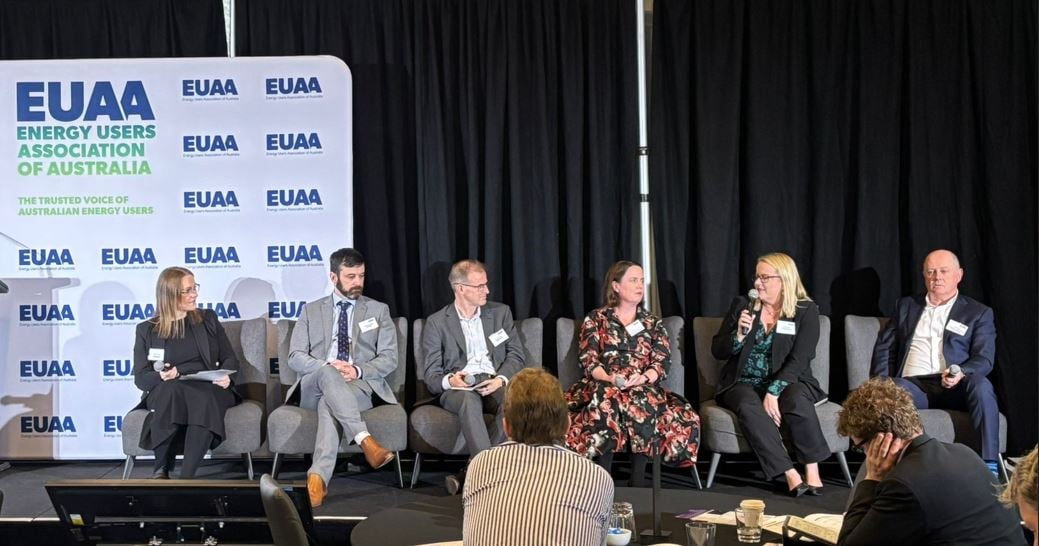Why the energy transition feels a lot like the movie "Speed"
This article shares key insights from the Energy Users Association of Australia (EUAA) National Conference 2025, where the urgency and complexity of Australia’s energy transition took centre stage. Using a Speed movie analogy, it unpacks the need for collaboration, affordability and smarter market design. It highlights the growing role of consumer energy resources, evolving policy frameworks, and the importance of long-term investment signals. SmartestEnergy calls for practical, inclusive pathways to help businesses decarbonise without derailing operations.

Reflections from the EUAA National Conference 2025
When I stepped up to welcome everyone to the Networking Drinks at the recent Energy Users Association of Australia (EUAA) National Conference in Melbourne, I opened with an analogy that, despite its 90s nostalgia, seemed to resonate with the room:
The energy transition is a lot like the movie Speed.
Stick with me here.
In Speed, a bus full of people can’t slow down below 50 km/h, or it will explode. For our energy system, think of that bus as Australian businesses, and that speed limit as the 50Hz frequency required to keep the electricity system stable.
We’re on this bus together. Eventually, we all need to jump off to a cleaner and more sustainable mode of transport. But how we do that, how safely, and how soon depends on each passenger’s capabilities, resources, and urgency.
There are people trying to help… and those accidentally (or deliberately) putting obstacles in the way. And the longer we stay on the fossil fuel bus, the closer we are to running out of road.
Humour aside, this analogy isn’t meant to trivialise the very real challenges businesses face during the energy transition. It’s tough, it’s fast-moving, and it’s risky. But with the right support, collaboration, and leadership, we can land safely.
Collaboration and trust: The backbone of the transition
One of the strongest threads across the conference, shared by government, business, industry experts, economists and grid operators alike, was this: collaboration and trust are essential.
Transitioning to renewables must be:
- Efficient (from both system and investment perspectives), and
- Affordable (so businesses can keep operating and investing).
As Ross Garnaut AC, Director of Zen Energy, reminded us in his opening keynote:
Great change takes time and needs political certainty and will.
Fortunately, following the recent federal election outcome, Australia now has a more stable, predictable political environment that enables long-term energy policy. This is a crucial ingredient for building the trust and investment certainty needed to transition Australia’s energy industry and economy between the public and private sectors towards net zero emissions.
Designing the market for the future
I was honoured to speak on the panel discussing the Future Energy Market Design, alongside experts, including Phil Hirshhorn, a member of the federal government’s review of the NEM’s wholesale market settings.
The focus isn’t on picking winners in generation technologies. Instead, the review asks: “What services does the system need and how do we structure the market to incentivise them?”
Think energy, capacity, inertia. Not just cheap kilowatts.
It’s not only about building the cheapest generation, it’s about ensuring the system gets the right mix of firmed renewables, storage, and flexibility to deliver energy when and where it’s needed, at the lowest total system cost.

Key takeaways from the panel discussion included:
- The Capacity Investment Scheme (CIS) is a good start but not a long-term market solution.
- Future settings must support investment in firming and flexible capacity, not just bulk generation.
- Supply chain bottlenecks are a significant concern and need government attention.
- We need standardised commercial models that help monetise consumer energy resources (CER).
From grid to consumer: Empowering participation
We heard from John Cleland, CEO of Essential Energy, who gave us insight into the opportunities of utilising existing capacity available in the distribution network to support new renewable energy and storage capacity. In doing so, producing better outcomes for the system and consumers through lower total system costs.
John reminded us of the potential billions in net benefits that can come from properly integrating consumer energy resources (CER) like batteries, EVs, and flexible demand.
In fact, a recent AEMC rule change will allow these smaller resources to be aggregated and actively participate in the NEM through voluntary dispatch, supported by financial incentives from 2026 to 2031.
This means companies with behind the meter resources and demand response capabilities (like many SmartestEnergy customers) could soon have new ways to generate value, if they’re ready.
Affordability is non-negotiable
EUAA CEO Andrew Richards cut to the heart of the matter:
The transition to net zero MUST be affordable or it will destroy demand and stall the transition.
He also highlighted some of the “messy middle” problems:
- Renewable energy is flowing in, but transmission upgrades are lagging.
- Costs of building that infrastructure haven’t yet hit consumers bills, but they will.
- There's a need to harmonise policies across mass market and C&I sectors to treat the energy market as a single system.
- The gas transition is under-prioritised, yet vital for decarbonisation.
In short, businesses increasingly face challenges in planning or investing in their energy future without confidence in affordability, policy direction, and infrastructure timelines.
A global perspective on local decisions
From a macroeconomic lens, Ric Deverell, Macquarie Group’s Chief Economist, shared insights into how geopolitics and global trade shifts affect Australia's energy sector.
His message? Stay the course.
Even if the US veers towards protectionism, Australia remains well-positioned, with relatively low net debt to GDP and strong economic fundamentals. The priority should be:
- Building green electrons,
- Retiring fossil assets, and
- Electrifying everything.
It’s not just about energy. It’s about securing Australia’s economic resilience and industrial competitiveness in a low-carbon world.
What’s next for SmartestEnergy customers?
At SmartestEnergy, we’re deeply engaged with these evolving market designs, incentive schemes, and demand-side opportunities. We believe:
- Businesses deserve clear pathways to participate in the energy transition.
- Retailers have a role in connecting consumers with the value of flexibility.
- Policy must deliver on the promise of affordability and inclusion, not just decarbonisation.
We’ll continue helping our customers jump off the fossil fuel bus (not just safely, but strategically) so they land where they want to be in 2030 and beyond.
Wrapping up with thanks
Hosting the EUAA Conference Networking Drinks was an absolute pleasure. It was heartening to see the enthusiasm, humility, and honesty in the room. This transition is complex, no doubt, but it's also full of opportunity.
To every business leader, energy user, industry colleague and policymaker I met: thank you for being part of the solution.
Because, in the end, whether you're Sandra Bullock driving the bus or Keanu Reeves saving the day, we're all on this journey together.
Angela Riley is the Head of Retail Sales at SmartestEnergy Australia. Her team is passionate about helping Australian businesses thrive in a clean energy future.
Stay Informed
To keep up with the latest energy market developments, follow us on LinkedIn for timely updates and insights.

Optimise your revenues
Our SmartestEnergy team of experts is here to support your green energy targets with realistic renewable energy solutions. Contact our team today to discover how SmartestEnergy can help and empower you to make smarter decisions for your business.
